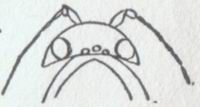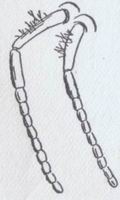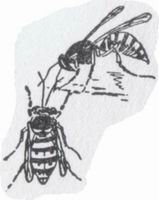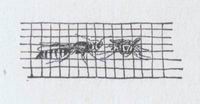|
1999-2004 (Return to Web Text-ures) |
Click Here to return to |
|
1999-2004 (Return to Web Text-ures) |
Click Here to return to |
WITHOUT EARS, THEY HEAR; WITHOUT NOSES, THEY
SMELL;
AND WITHOUT TONGUES, THEY CONVERSE.
ALL of which is possible because they possess antennae, the most remarkable organs of special sense, all things considered, in the world.
These sensitive feelers have their origin
between Vespa's eyes, and are necessary to her existence as well as to her
personal appearance.
She would look as unfinished without them as a man would without his ears or nose; and may it not be that in hornet-land the handsomest hornets and yellow-jackets are those distinguished by the beauty of these flexible organs?
The wasp's antennae are like those of the bee in structure, each one having a short, stiff handle, or “scape,” and a long, flexible tip, or “flagellum.” The scape moves freely at its point of union with the face, by a round ball-and-socket joint, and so serves to change the position of the flagellum, which is composed of numerous small joints covered with hearing and smelling organs of microscopic size.
At least we suppose they are so covered. Curious little sense-organs certainly there are on the antennae, and just as certainly the antennae are the organs of scent, -- though it may not be quite so evident they are also organs of hearing. However, it is believed they are.
 There are eleven short joints in the flagellum
of the female wasp, and twelve in that of the male.
There are eleven short joints in the flagellum
of the female wasp, and twelve in that of the male.
Besides the organs of hearing and of smell, the antennae bear a great number of short tactile hairs which are so sensitive that their little owners are doubtless able by means of them to discover the shapes and qualities of objects much more accurately than we could discover them by our blunter sense of touch.
Without the antennae the wasp would be deprived of the power of finding its food and of doing its work, and would soon perish. It has a keen sense of smell where food is concerned, and quickly finds a savoury morsel by scent alone, as has been proven by concealing meat near its nest.
By means of the antennae the wasps, like the bees, communicate with one another.
When two meet they at once question each other with their antennae ; if from the same nest, the newest comer is invited to share the honey it probably holds in its stomach, and this it is generally willing to do. If not from the same nest the Vespae generally retreat from each other without the formality of a duel, in this respect showing a much more peaceable nature than bees, for two bees meeting are very apt to fight at once, if they happen to belong to different hives.

Although the wasp has no separate honey-sac like that of the bee, it has a stomach in which it can carry quite a large drop of honey, and this honey it can regurgitate.
Some species of wasps store a sort of honey in their combs, but it is a very poor substitute for the glorious nectar of the hives; and in Brazil a certain wasp manufactures a honey dangerous to eat, as it occasions dizziness and sharp pains in the stomach.
“The naturalist Auguste Saint-Hilaire, during his sojourn in Brazil, himself experienced ill-effects from eating it.”
Hornets and yellow-jackets are fond of sweets,
and when a captive Vespa is given honey or syrup the office of the antennae is
at once apparent. These delicate threads are turned towards the inviting
delicacy, they are gently waved and tilted and balanced as her ladyship moves
nearer and nearer, until the delicate tips finally touch the object of interest;
all doubt as to its nature vanishes, and Vespa at once forgets the sorrows of
captivity in long, delightful draughts.
Whoever longs for the fellowship of wasps can make their acquaintance and watch their actions with perfect safety by confining them in a cage made of a cardboard box without a cover and with large openings cut in the sides, the whole covered by wire netting. The care they need is nothing compared to the pleasure and instruction they may afford, as a daily dewy leaf to drink from, and a lump of moist sugar to stay the pangs of hunger are all the attention they require. The occupants for these cages are caught with an insect net on the flowers the wasps frequent.
Such Vespae become quite tame, and as, unlike bees, they do not sting strangers of their own kind, any number can be safely put together in the same cage.